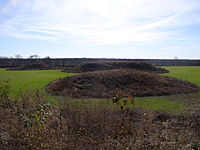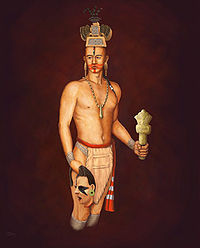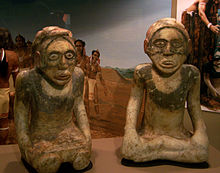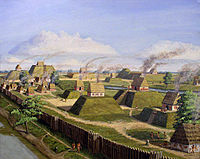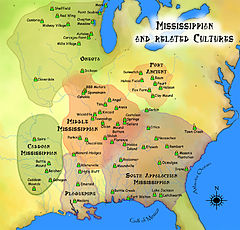- Mississippian culture
-
The Mississippian culture was a mound-building Native American culture that flourished in what is now the Midwestern, Eastern, and Southeastern United States from approximately 800 CE to 1500 CE, varying regionally.[1]
The Mississippian way of life began to develop in the Mississippi River Valley (for which it is named). Cultures in the tributary Tennessee River Valley may have also begun to develop Mississippian characteristics at this point. Almost all dated Mississippian sites predate 1539-1540 (when Hernando de Soto explored the area).[citation needed]
Contents
Cultural traits
A number of cultural traits are recognized as being characteristic of the Mississippians. Although not all Mississippian peoples practiced all of the following activities, they were distinct from their ancestors in adoption of some or all of these traits.
- The construction of large, truncated earthwork pyramid mounds, or platform mounds. Such mounds were usually square, rectangular, or occasionally circular. Structures (domestic houses, temples, burial buildings, or other) were usually constructed atop such mounds.
- Maize-based agriculture. In most places, the development of Mississippian culture coincided with adoption of comparatively large-scale, intensive maize agriculture, which supported larger populations and craft specialization.
- The adoption and use of riverine (or more rarely marine) shell-tempering agents in their ceramics.
- Widespread trade networks extending as far west as the Rockies, north to the Great Lakes, south to the Gulf of Mexico, and east to the Atlantic Ocean.
- The development of the chiefdom or complex chiefdom level of social complexity.
- The development of institutionalized social inequality.
- A centralization of control of combined political and religious power in the hands of few or one.
- The beginnings of a settlement hierarchy, in which one major center (with mounds) has clear influence or control over a number of lesser communities, which may or may not possess a smaller number of mounds.
- The adoption of the paraphernalia of the Southeastern Ceremonial Complex (SECC), also called the Southern Cult. This is the belief system of the Mississippians as we know it. SECC items are found in Mississippian-culture sites from Wisconsin (see Aztalan State Park) to the Gulf Coast, and from Florida to Arkansas and Oklahoma. The SECC was frequently tied in to ritual game-playing, as with chunkey.
The Mississippians had no writing system or stone architecture. They worked naturally occurring metal deposits, but did not smelt iron or make bronze metallurgy.
Chronology
The Mississippian stage is usually divided into three or more periods. Each of these periods is an arbitrary historical distinction that varies from region to region. At one site, each period may be considered to begin earlier or later, depending on the speed of adoption or development of given Mississippian traits.
- Early Mississippian cultures had just transitioned from the Late Woodland period way of life (500–1000 C.E.). Different groups abandoned tribal lifeways for increasing complexity, sedentism, centralization, and agriculture. The Early Mississippian period was from c. 1000 to 1200 C.E. Production of surplus corn and attractions of the regional chiefdoms led to rapid population concentrations in major centers.
- The Middle Mississippian period is often considered the high point of the Mississippian era. The expansion of the great metropolis and ceremonial complex at Cahokia (in present-day Illinois), the formation of other complex chiefdoms, and the spread and development of SECC art and symbolism are characteristic changes of this period. The Mississippian traits listed above came to be widespread throughout the region. In most places, this period is recognized as occurring c. 1200–1400 C.E.
- The Late Mississippian period, usually considered from c. 1400 to European contact, is characterized by increasing warfare, political turmoil, and population movement. The population of Cahokia dispersed early in this period (1350–1400), perhaps migrating to other rising political centers. More defensive structures are often seen at sites, and sometimes a decline in mound-building and ceremonialism. Although some areas continued an essentially Middle Mississippian culture until the first significant contact with Europeans, the population of most areas had dispersed or were experiencing severe social stress by 1500.[2][3][4] Along with the contemporary Anasazi, these cultural collapses coincide with the global climate change of the Little Ice Age. Scholars have theorized that drought and the collapse of maize agriculture, together with possible deforestation and overhunting by the concentrated populations, forced them to move away from major sites.
Contact with Europeans
At Joara, near Morganton, North Carolina, Native Americans of the Mississippian culture interacted with Spanish explorers of the Juan Pardo expedition, who built a base there in 1567 called Fort San Juan. Expedition documentation and archaeological evidence of the fort and Native American culture both exist. The soldiers were at the fort about 18 months (1567–1568) before the natives killed them and destroyed the fort. (They killed soldiers stationed at five other forts as well; only one man of 120 survived.) Sixteenth-century Spanish artifacts have been recovered from the site, marking the first European colonization in the interior of what became the United States.[5]
Scholars have studied the records of Hernando de Soto's expedition of 1539–1543 to learn of his contacts with Mississippians, as he traveled through their villages of the Southeast. He visited many villages, in some cases staying for a month or longer. The List of sites and peoples visited by the Hernando de Soto Expedition chronicles those villages. Some encounters were violent, while others were relatively peaceable. In some cases, de Soto seems to have been used as a tool or ally in long-standing native feuds. In one example, de Soto negotiated a truce between the Pacaha and the Casqui.
De Soto's later encounters left about half of the Spaniards and perhaps many hundreds of Native Americans dead. The chronicles of de Soto are among the first documents written about Mississippian peoples, and are an invaluable source of information on their cultural practices. The chronicles of the Narváez expedition were written before the de Soto expedition; the Narváez expedition that informed the Court of de Soto about the New World.
After the destruction and flight of the de Soto expedition, the Mississippian peoples continued their way of life with little direct European influence. Indirectly, however, European introductions dramatically changed native societies in the Eastern United States. Because the natives lacked immunity to new infectious diseases, such as measles and smallpox, epidemics caused so many fatalities that they undermined the social order of many chiefdoms. Some groups adopted European horses and changed to nomadism.[6] Political structures collapsed in many places.
By the time more documentary accounts were being written, the Mississippian way of life had changed irrevocably. Some groups maintained an oral tradition link to their mound-building past, such as the late 19th-century Cherokee[7]. Other Native American groups, having migrated many hundreds of miles and lost their elders to diseases, did not know their ancestors had built the mounds dotting the landscape. This contributed to the myth of the Mound Builders as a people distinct from Native Americans, which was rigorously debunked by Cyrus Thomas in 1894.
Known Mississippian chiefdoms
Hollow ceramic jug showing the underwater panther from the Mississippian culture, found at Rose Mound in Cross County, Arkansas, U.S., 1400-1600. height: 8 inches (20 cm).
Although the Mississippian culture was severely disrupted before Europeans documented its political landscape, explorers wrote about many Mississippian political bodies and others have been discovered by research. Some of the major sites are listed below; for a more comprehensive list see List of Mississippian sites.
- Angel Mounds: A chiefdom in southern Indiana near Evansville. Some archaeologists think that the Late Mississippian Caborn-Welborn culture developed from the Angel Phase people around 1400 CE and lasted to around 1700 CE.[8]
- Cahokia: Near East St. Louis, Illinois, Cahokia was possibly the first, and certainly the largest and most influential, of the Mississippian culture centers.
- Emerald Mound: A Plaquemine Mississippian period archaeological site located on the Natchez Trace Parkway (near present-day Stanton, Mississippi developed nearby). The site dates from the period between 1200 and 1730 CE. The platform mound is the second-largest Pre-Columbian earthwork in the country, after Monks Mound at Cahokia.
- Etowah: One of the major Mississippian chiefdoms, located in Georgia, believed by some to be a longstanding antagonist of the Moundville polity.
- Grand Village of the Natchez: The main village of the Natchez people, with three mounds. The only mound site to be used and maintained into historic times.
- Kincaid Site: A major Mississippian mound center in southern Illinois across the Ohio River from present-day Paducah, Kentucky.
- Moundville: Ranked with Cahokia as one of the two most important sites at the core of the Mississippian culture[9], located near Tuscaloosa, Alabama.
- Ocmulgee: Originally a Mississippian chiefdom, the site was later used by the Creek Indians into historic times.
- The Parkin Site: The type site for the "Parkin phase", an expression of Late Mississippian culture, believed by many archaeologists to be the province of Casqui visited by Hernando de Soto in 1542.[10]
- Spiro Mounds: One of the best-studied archaeological centers of Caddoan Mississippian culture, located in eastern Oklahoma.
Related modern nations
Mississippian peoples were almost certainly ancestral to the majority of the American Indian nations living in this region in the historic era. The historic and modern day American Indian nations believed to have descended from the overarching Mississippian Culture include: the Alabama, Apalachee, Caddo, Cherokee, Chickasaw, Choctaw, Creek, Guale, Hitchiti, Houma, Kansa, Missouri, Mobilian, Natchez, Osage Nation, Quapaw, Seminole, Tunica-Biloxi, Yamasee, and Yuchi.[citation needed]
See also
- List of Mississippian sites
- List of burial mounds in the United States
- Southeastern Ceremonial Complex
Notes
- ^ Adam King, "Mississippian Period: Overview", New Georgia Encyclopedia, 2002, accessed 15 Nov 2009
- ^ Pauketat, Timothy R. (2003) “Resettled Farmers and the Making of a Mississippian Polity,” American Antiquity Vol. 68 No. 1
- ^ Pauketat, Timothy R. (1998) “Refiguring the Archaeology of Greater Cahokia,” Journal of Archaeological Research Vol. 6 No. 1
- ^ Sullivan, Lynne P., Archaeology of the Appalachian Highlands, Univ. of Tennessee Press, 2001 ISBN 1-57233-142-9
- ^ Constance E. Richards, "Contact and Conflict", American Archaeologist, Spring 2004, accessed 26 Jun 2008
- ^ Bense pp. 256–257, 275–279
- ^ Hudson pp. 334
- ^ David Pollack (2004). Caborn-Welborn - Constructing a New Society after the Angel Chiefdom Collapse. University of Alabama Press. p. Pp. 24. ISBN 0-8173-5126-4.
- ^ "Southeastern Prehistory: Mississippian and Late Prehistoric Period". "National Park Service". http://www.nps.gov/history/seac/outline/05-mississippian/index.htm. Retrieved 2007-12-04.
- ^ Hudson, Charles M. (1997). Knights of Spain, Warriors of the Sun. University of Georgia Press.
External references
- Bense, Judith A. Archaeology of the Southeastern United States: Paleoindian to World War I. Academic Press, New York, 1994. ISBN 0-12-089060-7.
- Cheryl Anne Cox; and David H. Dye, eds; Towns and Temples along the Mississippi University of Alabama Press 1990
- Hudson, Charles; The Southeastern Indians. University of Tennessee Press, Knoxville, 1976. ISBN 0-87049-248-9.
- O'Conner, Mallory McCane. Lost Cities of the Ancient Southeast. University Press of Florida, Florida A & M University, Gainesville, Fla., 1995. ISBN 0-8130-1350-X.
- Pauketat, Timothy R.; The Ascent of Chiefs: Cahokia and Mississippian Politics in Native North America. University of Alabama Press, 1994, ISBN 978-0817307288.
- Pauketat, Timothy R.; “The History of the Mississippians” in North American Archaeology Blackwell Publishing Ltd., 2005.
External links
- The Mississippian and Late Prehistoric Period, National Park Service Southeastern Archaeology Center
- Mississippian World, Texas Beyond History
- Cahokia Mounds
- Etowah Indian Mounds State Historic Site
- Indian Mounds of Mississippi, a National Park Service Discover Our Shared Heritage Travel Itinerary
- Moundville Archaeological Park
- Chucalissa Museum and Archaeological site
- Encyclopedia of Alabama: Mississippian Period
- Animation: Towns and Temples of the Mississippian Culture-5 Sites
 Pre-Columbian North America
Pre-Columbian North AmericaArchaeological cultures North American pre-Columbian chronology – Adena – Alachua – Ancient Pueblo (Anasazi) – Baytown – Belle Glade – Buttermilk Creek Complex – Caborn-Welborn – Calf Creek – Caloosahatchee – Clovis – Coles Creek – Deptford – Folsom – Fort Ancient – Fort Walton – Fremont – Glades – Glacial Kame – Hopewell (List of Hopewell sites) – Hohokam – Leon-Jefferson – Mississippian (List of Mississippian sites) – Mogollon – Monongahela – Old Cordilleran – Oneota – Paleo-Arctic – Paleo-Indians – Patayan – Plano – Plaquemine – Poverty Point – Prehistoric Southwest – Red Ocher – Santa Rosa-Swift Creek – St. Johns – Steed-Kisker – Tchefuncte – Tocobaga – Troyville
Archaeological sites Angel Mounds – Bandelier National Monument – The Bluff Point Stoneworks – Cahokia – Chaco Canyon – Casa Grande – Coso Rock Art District – Eaker – Effigy Mounds National Monument – Etowah Indian Mounds – Eva – Folsom Site – Fort Ancient – Fort Center – Gila Cliff Dwellings National Monument – Holly Bluff Site – Hopewell Culture National Historical Park – Kincaid Mounds – Kolomoki – Manitou Cliff Dwellings – Marksville – Meadowcroft Rockshelter – Mesa Verde – Moorehead Circle – Moundville – Mummy Cave – Nodena Site – Ocmulgee National Monument – Old Stone Fort – Parkin Park – Pinson Mounds – Portsmouth Earthworks – Poverty Point – Pueblo Bonito – Rock Eagle – Rock Hawk – Salmon Ruins – Serpent Mound – Spiro Mounds – SunWatch – Taos Pueblo – Toltec Mounds – Town Creek Indian Mound – WintervilleMiscellaneous Ballgame – Black drink – Buhl woman – Calumet – Chunkey – Clovis point – Container Revolution – Eastern Agricultural Complex – Eden point – Effigy mound – Falcon dancer – Folsom point – Green Corn Ceremony – Horned Serpent – Kennewick man – Kiva – Metallurgy – Mi'kmaq hieroglyphic writing – Medicine wheel – Mound builders – N.A.G.P.R.A. – Norse colonization of the Americas – Piasa – Pueblo dwellings – Southeastern Ceremonial Complex – Three Sisters agriculture – Thunderbird – Underwater panther
Categories:- Mississippian culture
- Mound builders (people)
- Archaeological cultures of North America
- History of indigenous peoples of North America
- Native American history
- Formative period in the Americas
- Indigenous peoples of the Southeastern Woodlands
- Great Lakes tribes
- Mississippi River
- Civilizations
Wikimedia Foundation. 2010.


